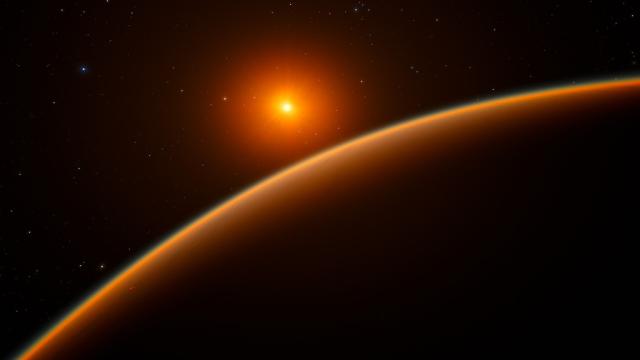It seems like every week, there’s a new contender for Coolest Planet Where There Are Definitely Aliens. For those of us who want to believe, this is an emotionally exhausting cycle, as we’re built up and let down time and again. At the risk of screwing with our fragile hearts even more, it’s worth mentioning that a recently discovered exoplanet 39 light-years from Earth might actually give the current favourites — Proxima b and the TRAPPIST-1 system — a run for their money.
Artist’s rendition of exoplanet LHS 1140b. (Image: ESO/spaceengine.org)
This rookie, known as LHS 1140b, hails from the constellation Cetus (the sea monster). It was initially discovered in 2014 by Harvard astronomers who are part of The MEarth Project, which hunts for exoplanets. The team first spotted the rocky planet using the transit method, meaning they noticed a dip in the light output of its parent star, a red dwarf called LHS 1140, when it passed in front in our line of sight.
“We originally thought it was just something funny going on in the atmosphere,” Harvard astronomer Jason Dittmann, the study’s lead author, told Gizmodo. “It was only about a year later, when I was going back through our data with a machine learning based algorithm… that I pulled this 2014 transit out and flagged it as possibly real.”
Dittmann and his team of researchers followed up on the observation using the European Southern Observatory (ESO) HARPS instrument, which allowed them to confirm the planet’s orbital period, mass and density. The group’s research will be published in Nature on April 20 (nice).
Though it’s much closer to its sun than Earth is to ours, LHS 1140 is a lot cooler than our life-giving buddy. It just so happens that as a result, LHS 1140b lies squarely in the habitable zone, which means that hypothetically, it could support flowing water. Even though it’s only about 1.4 times the size Earth, it’s about seven times as massive, indicating that it is probably a rocky world with a dense iron core. Naturally, researchers are already pumped about the possibility of life there.
“This is the most exciting exoplanet I’ve seen in the past decade,” Dittmann said in a statement. “We could hardly hope for a better target to perform one of the biggest quests in science — searching for evidence of life beyond Earth.”
It isn’t just enough to be excited about this planet, though; there’s a bit of exoplanetary competition going on here. Even the researchers are having some fun encouraging the rivalry between LHS 1140b; Proxima b, a potentially Earth-like exoplanet discovered just five light years away in 2016; and the seven Earth-sized planets recently spotted around the ultracool dwarf star TRAPPIST-1.
“The LHS 1140 system might prove to be an even more important target for the future characterization of planets in the habitable zone than Proxima b or TRAPPIST-1,” researchers Xavier Delfosse and Xavier Bonfils said. “This has been a remarkable year for exoplanet discoveries!”
Still, Dittmann thinks that the TRAPPIST-1 system, also located roughly 40 light years away, stands out as a particularly intriguing.
“I really want to emphasise that both our system and TRAPPIST-1 are exciting and both worthy of intense future study,” he told Gizmodo. “LHS 1140 is brighter at optical wavelengths because it’s slightly bigger than the TRAPPIST-1 star. So, when the future 30 meter optical telescopes are built (the Giant Magellan Telecopes and European Extremely Large Telescope), LHS 1140 can feasibly be studied by these telescopes.”
Indeed, we won’t know much more about any of these planets’ habitability until we can observe their atmospheres, which will require more powerful telescopes than today’s state-of-the-art. There are already concerns about the habitability of Proxima b, which, like LHS 1140b, orbits a red dwarf. Some scientists worry that the frequent solar storms from Proxima b’s host star could strip it of its atmosphere, dashing our chances of finding biosignatures there. It’s possible this could be a concern with LHS 1140b, too.
“There’s definitely a concern that high energy radiation from M dwarfs might ‘spoil’ the habitability of their planets,” Dittmann said. “In the case of Proxima b, the star seems to be very active, flaring quite often. This is also true in the case of TRAPPIST-1. In contrast, LHS 1140 is slowly rotating (130 days), and we haven’t seen any flares from the star. We also expect — and hope to check with future data — that the star is very quiet at high energies as well. So, at least in the present day, LHS 1140b finds itself orbiting a very nice, quiet host star.”
Ultimately, time will tell. NASA’s James Webb Telescope (JWT), which is set to launch in October 2018, could provide some of the answers alien hunters astronomers are desperately seeking. Once it’s completed, JWT will be the most powerful space-based telescope ever deployed — it will be used to peer into the atmospheres of all of these planets and more.
When it comes to exoplanetary supremacy, there can only be one. Just kidding, I hope they all have alien babies hiding inside them.
[ESO]
